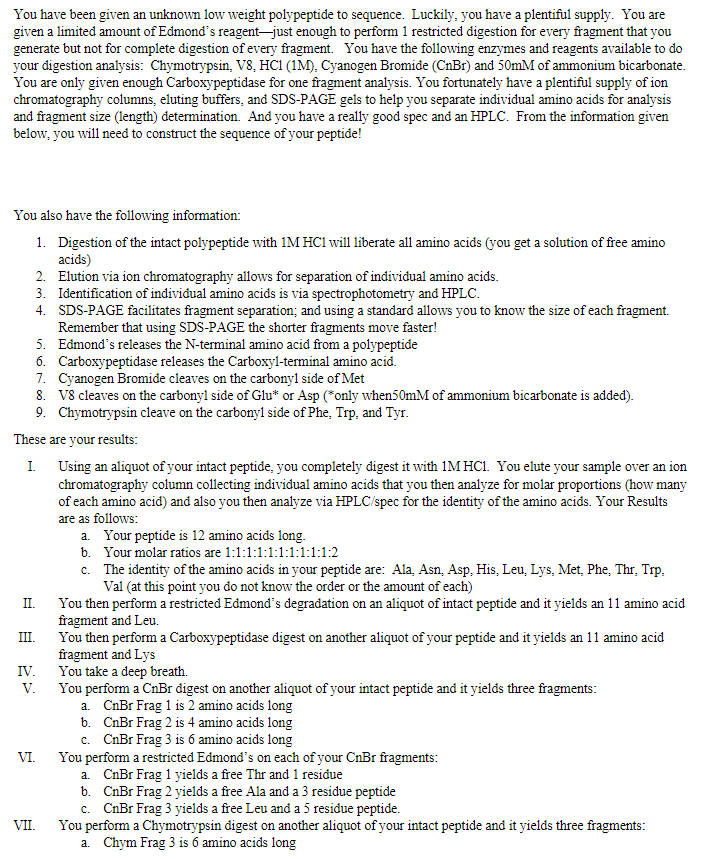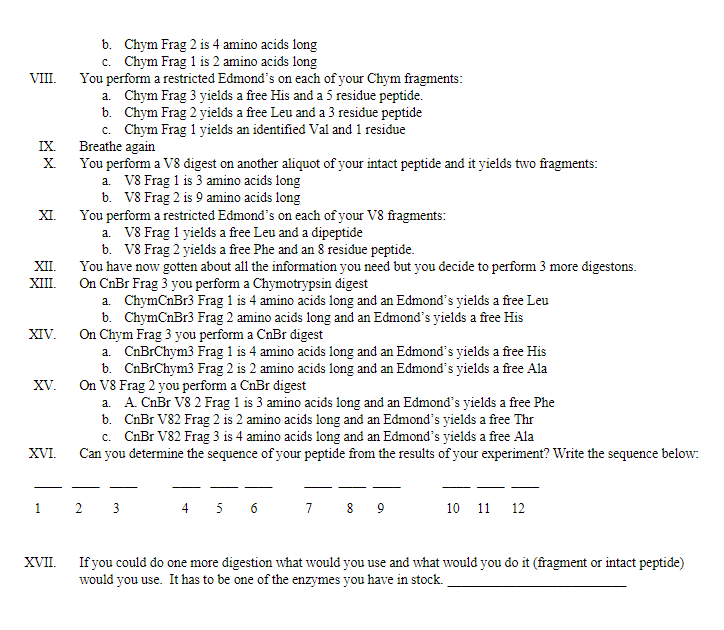You have been given an unknown low weight polypeptide to sequence. Luckily, you have a plentiful supply. You are given a limited amount of Edmond's reagent-just enough to perform 1 restricted digestion for every fragment that you generate but not for complete digestion of every fragment. You have the following enzymes and reagents available to do your digestion analysis: Chymotrypsin, V8, HC1 (1M), Cyanogen Bromide (CnBr) and 50MM of ammonium bicarbonate. You are only given enough Carboxypeptidase for one fragment analysis. You fortunately have a plentiful supply of ion chromatography columns, eluting buffers, and SDS-PAGE gels to help you separate individual amino acids for analysis and fragment size (length) determination. And you have a really good spec and an HPLC. From the information given below, you will need to construct the sequence of your peptide!
You have been given an unknown low weight polypeptide to sequence. Luckily, you have a plentiful supply. You are given a limited amount of Edmond's reagent-just enough to perform 1 restricted digestion for every fragment that you generate but not for complete digestion of every fragment. You have the following enzymes and reagents available to do your digestion analysis: Chymotrypsin, V8, HC1 (1M), Cyanogen Bromide (CnBr) and 50MM of ammonium bicarbonate. You are only given enough Carboxypeptidase for one fragment analysis. You fortunately have a plentiful supply of ion chromatography columns, eluting buffers, and SDS-PAGE gels to help you separate individual amino acids for analysis and fragment size (length) determination. And you have a really good spec and an HPLC. From the information given below, you will need to construct the sequence of your peptide!
Biochemistry
9th Edition
ISBN:9781319114671
Author:Lubert Stryer, Jeremy M. Berg, John L. Tymoczko, Gregory J. Gatto Jr.
Publisher:Lubert Stryer, Jeremy M. Berg, John L. Tymoczko, Gregory J. Gatto Jr.
Chapter1: Biochemistry: An Evolving Science
Section: Chapter Questions
Problem 1P
Related questions
Question

Transcribed Image Text:You have been given an unknown low weight polypeptide to sequence. Luckily, you have a plentiful supply. You are
given a limited amount of Edmond's reagent-just enough to perform 1 restricted digestion for every fragment that you
generate but not for complete digestion of every fragment. You have the following enzymes and reagents available to do
your digestion analysis: Chymotrypsin, V8, HCI (1M), Cyanogen Bromide (CnBr) and 50mM of ammonium bicarbonate.
You are only given enough Carboxypeptidase for one fragment analysis. You fortunately have a plentiful supply of ion
chromatography columns, eluting buffers, and SDS-PAGE gels to help you separate individual amino acids for analysis
and fragment size (length) determination. And you have a really good spec and an HPLC. From the information given
below, you will need to construct the sequence of your peptide!
You also have the following information:
1. Digestion of the intact polypeptide with 1M HCl will liberate all amino acids (you get a solution of free amino
acids)
2. Elution via ion chromatography allows for separation of individual amino acids.
3. Identification of individual amino acids is via spectrophotometry and HPLC.
4. SDS-PAGE facilitates fragment separation; and using a standard allows you to know the size of each fragment.
Remember that using SDS-PAGE the shorter fragments move faster!
5. Edmond's releases the N-terminal amino acid from a polypeptide
6. Carboxypeptidase releases the Carboxyl-terminal amino acid.
7. Cyanogen Bromide cleaves on the carbonyl side of Met
8. V8 cleaves on the carbonyl side of Glu* or Asp (*only when50mM of ammonium bicarbonate is added).
9. Chymotrypsin cleave on the carbonyl side of Phe, Trp, and Tyr.
These are your results:
I. Using an aliquot of your intact peptide, you completely digest it with 1M HC1. You elute your sample over an ion
chromatography column collecting individual amino acids that you then analyze for molar proportions (how many
of each amino acid) and also you then analyze via HPLC/spec for the identity of the amino acids. Your Results
are as follows:
a. Your peptide is 12 amino acids long.
b. Your molar ratios are 1:1:1:1:1:1:1:1:1:1:2
c. The identity of the amino acids in your peptide are: Ala, Asn, Asp, His, Leu, Lys, Met, Phe, Thr, Trp,
Val (at this point you do not know the order or the amount of each)
You then perform a restricted Edmond's degradation on an aliquot of intact peptide and it yields an 11 amino acid
fragment and Leu.
You then perform a Carboxypeptidase digest on another aliquot of your peptide and it yields an 11 amino acid
fragment and Lys
You take a deep breath.
You perform a CnBr digest on another aliquot of your intact peptide and it yields three fragments:
a. CnBr Frag 1 is 2 amino acids long
b. CnBr Frag 2 is 4 amino acids long
c. CnBr Frag 3 is 6 amino acids long
You perform a restricted Edmond's on each of your CnBr fragments:
a. CnBr Frag 1 yields a free Thr and 1 residue
b. CnBr Frag 2 yields a free Ala and a 3 residue peptide
c. CnBr Frag 3 yields a free Leu and a 5 residue peptide.
You perform a Chymotrypsin digest on another aliquot of your intact peptide and it yields three fragments:
a. Chym Frag 3 is 6 amino acids long
II.
III.
IV.
V.
VI.
VII.

Transcribed Image Text:b. Chym Frag 2 is 4 amino acids long
c. Chym Frag 1 is 2 amino acids long
You perform a restricted Edmond's on each of your Chym fragments:
a. Chym Frag 3 yields a free His and a 5 residue peptide.
b. Chym Frag 2 yields a free Leu and a 3 residue peptide
c. Chym Frag 1 yields an identified Val and 1 residue
Breathe again
You perform a V8 digest on another aliquot of your intact peptide and it yields two fragments:
a. V8 Frag 1 is 3 amino acids long
b. V8 Frag 2 is 9 amino acids long
You perform a restricted Edmond's on each of your V8 fragments:
a. V8 Frag 1 yields a free Leu and a dipeptide
b. V8 Frag 2 yields a free Phe and an 8 residue peptide.
You have now gotten about all the information you need but you decide to perform 3 more digestons.
On CnBr Frag 3 you perform a Chymotrypsin digest
a. ChymCnBr3 Frag 1 is 4 amino acids long and an Edmond's yields a free Leu
b. ChymCnBr3 Frag 2 amino acids long and an Edmond's yields a free His
On Chym Frag 3 you perform a CnBr digest
a. CnBrChym3 Frag 1 is 4 amino acids long and an Edmond's yields a free His
b. CnBrChym3 Frag 2 is 2 amino acids long and an Edmond's yields a free Ala
On V8 Frag 2 you perform a CnBr digest
a. A. CnBr V8 2 Frag 1 is 3 amino acids long and an Edmonď's yields a free Phe
b. CnBr V82 Frag 2 is 2 amino acids long and an Edmond's yields a free Thr
c. CnBr V82 Frag 3 is 4 amino acids long and an Edmond's yields a free Ala
Can you determine the sequence of your peptide from the results of your experiment? Write the sequence below:
VIII
IX.
X.
XI.
XII.
XII.
XIV.
XV.
XVI.
1.
3
4
5 6
7
8 9
10 11 12
XVII.
If you could do one more digestion what would you use and what would you do it (fragment or intact peptide)
would you use. It has to be one of the enzymes you have in stock.
Expert Solution
This question has been solved!
Explore an expertly crafted, step-by-step solution for a thorough understanding of key concepts.
This is a popular solution!
Trending now
This is a popular solution!
Step by step
Solved in 3 steps with 1 images

Recommended textbooks for you

Biochemistry
Biochemistry
ISBN:
9781319114671
Author:
Lubert Stryer, Jeremy M. Berg, John L. Tymoczko, Gregory J. Gatto Jr.
Publisher:
W. H. Freeman

Lehninger Principles of Biochemistry
Biochemistry
ISBN:
9781464126116
Author:
David L. Nelson, Michael M. Cox
Publisher:
W. H. Freeman

Fundamentals of Biochemistry: Life at the Molecul…
Biochemistry
ISBN:
9781118918401
Author:
Donald Voet, Judith G. Voet, Charlotte W. Pratt
Publisher:
WILEY

Biochemistry
Biochemistry
ISBN:
9781319114671
Author:
Lubert Stryer, Jeremy M. Berg, John L. Tymoczko, Gregory J. Gatto Jr.
Publisher:
W. H. Freeman

Lehninger Principles of Biochemistry
Biochemistry
ISBN:
9781464126116
Author:
David L. Nelson, Michael M. Cox
Publisher:
W. H. Freeman

Fundamentals of Biochemistry: Life at the Molecul…
Biochemistry
ISBN:
9781118918401
Author:
Donald Voet, Judith G. Voet, Charlotte W. Pratt
Publisher:
WILEY

Biochemistry
Biochemistry
ISBN:
9781305961135
Author:
Mary K. Campbell, Shawn O. Farrell, Owen M. McDougal
Publisher:
Cengage Learning

Biochemistry
Biochemistry
ISBN:
9781305577206
Author:
Reginald H. Garrett, Charles M. Grisham
Publisher:
Cengage Learning

Fundamentals of General, Organic, and Biological …
Biochemistry
ISBN:
9780134015187
Author:
John E. McMurry, David S. Ballantine, Carl A. Hoeger, Virginia E. Peterson
Publisher:
PEARSON